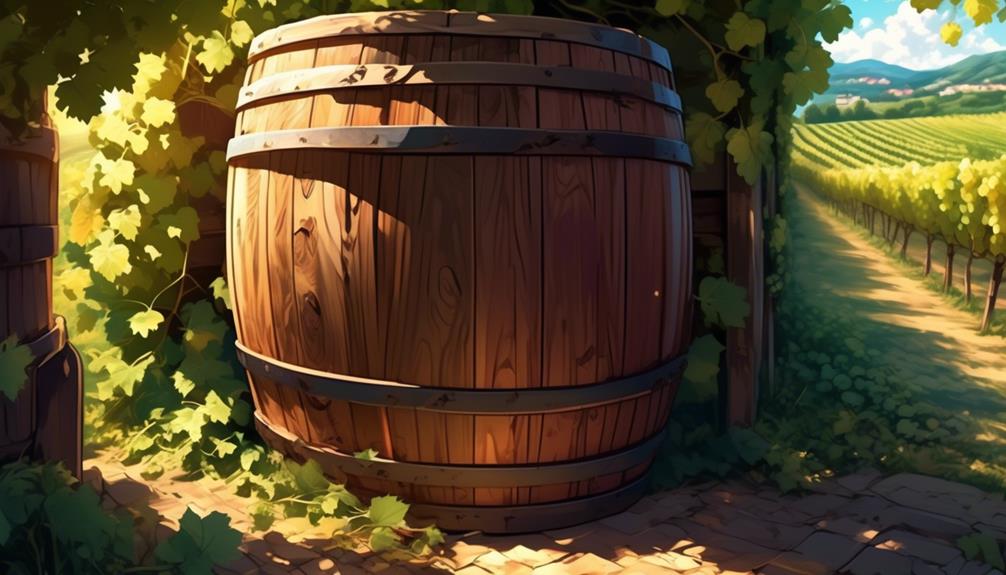Like a vineyard tucked away in the rolling hills, the art of making your own country wine at home is a hidden gem waiting to be discovered.
With each sip, you can taste the fruits of your labor and experience the satisfaction of crafting something truly unique.
But how does one embark on this journey? What equipment is needed? Which ingredients should you choose? In this discussion, we will unravel the secrets of country wine making, guiding you through the process step by step.
Get ready to uncork a world of possibilities, for your taste buds are in for a treat.
Country Wine Basics…
- Country wine is a versatile fermented beverage made from fruits, vegetables, herbs, and flowers, offering endless possibilities for experimentation and unique flavors.
- The process of making country wine involves simple fermentation, making it easy for beginners to learn.
- Essential wine making equipment includes a large bucket for primary fermentation, demijohns for secondary fermentation and aging, tubing for smooth transfer of wine between containers, rubber corks and air-locks to seal demijohns and prevent contamination, and additional items like measuring jugs and kitchen utensils.
- When making country wine, it’s important to select high-quality ingredients and sweeteners, consider the season and availability of fruits, vegetables, herbs, and flowers, and understand the importance of yeast, sugar, and water levels for fruit wines.
- Additives like tannin powder or citric acid can enhance flavor, and common additives include Campden tablets, pectic enzyme, yeast nutrient, acid blend, and fining agents.
What Is Country Wine?
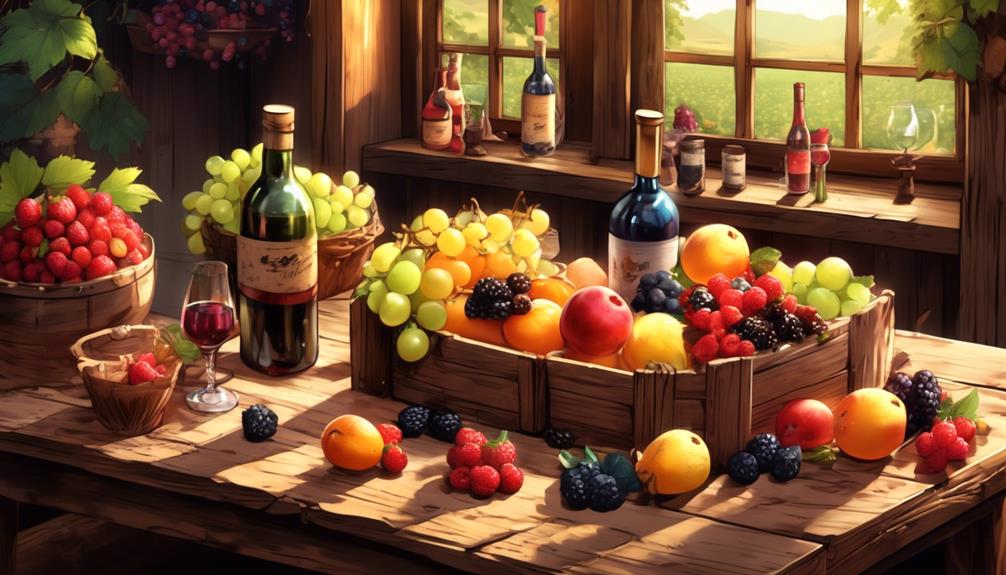
Country wine is a delightful and versatile fermented beverage, distinct from traditional grape wines (although grapes can certainly be used), that opens up a world of creative possibilities for the resourceful home winemaker.
Unlike grape wines, country wines are made using a variety of ingredients such as fruits, vegetables, herbs, and flowers, allowing for endless experimentation and flavors.
The process of making homemade country wine involves a simple fermentation method that can be easily mastered by beginners.
To start making country wine, you’ll need a few key ingredients.
First, choose your desired fruits or other ingredients and prepare them accordingly. Next, and only if needed depending on what type of wine you’re making, you’ll need to add sugar to the mixture, as this is what the yeast will feed on during the fermentation process. The amount of sugar will depend on your taste preference and the sweetness of the fruit.
Additionally, you’ll need wine yeast to initiate the fermentation process.
The fermentation process for making country wine is similar to that of basic wine making. The ingredients are combined in one container, along with the wine yeast. It’s important to provide the yeast with the right conditions to thrive, such as a warm and dark environment. After a few days, you’ll start to see bubbles forming, indicating that the fermentation process is underway.
To enhance the flavor and complexity of your country wine, you can also add other ingredients such as strong black tea or a splash of lemon juice. These additions can add depth and character to your homemade creation.
Once the fermentation process is complete, you can strain the liquid and transfer it to another container for aging. However, unlike traditional grape wines, country wines don’t require lengthy aging and can be enjoyed relatively quickly.
Making country wine at home opens up a whole new world of possibilities. Whether you choose to use fruits, vegetables, herbs, or even flowers, the options for creating unique and delicious flavors are endless. With basic knowledge of fermentation and a few simple ingredients, you can embark on a journey of homemade country wine making and discover your own signature recipes.
‘Did You Know? In history, country wines were often made by farmers and home winemakers who had an abundance of fruits and vegetables and wanted to preserve their harvest. These wines were often unique to each region based on the local produce available. Today, this tradition of making wine from local ingredients continues in homes and wineries around the world, making each bottle of country wine a unique expression of its origin.’
Essential Wine Making Equipment
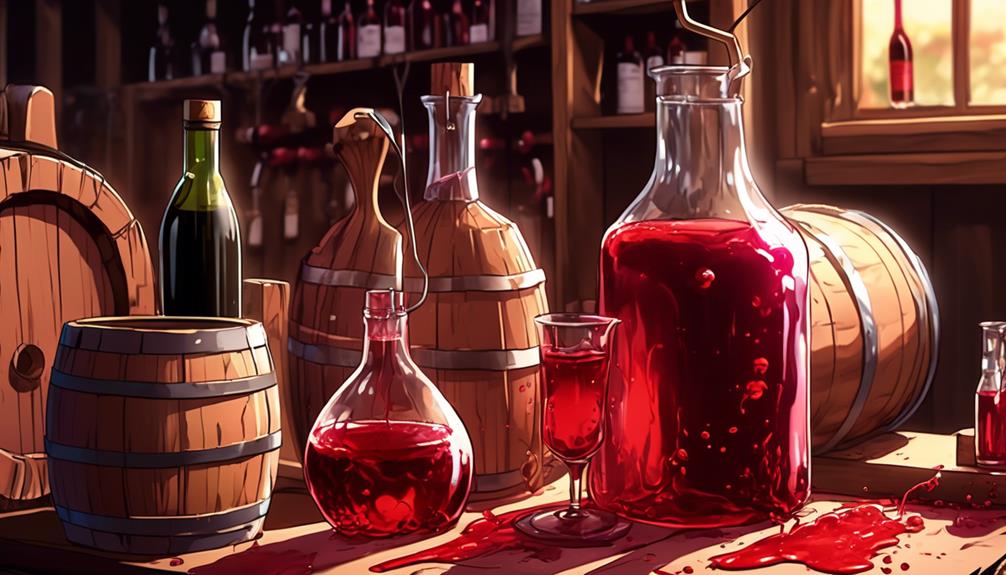
Now that you’re ready to embark on your homemade country wine making journey, let’s explore the essential wine making equipment you’ll need to bring your flavorful creations to life.
To successfully make your own wine at home, you’ll need the following essential equipment:
- Large Bucket: This is where the magic begins. The bucket will be used for primary fermentation, where the yeast will work its magic and transform the fruit into alcohol.
- Demijohns: These glass containers are perfect for the secondary fermentation process. They allow the wine to age and develop its complex flavors.
- Tubing: You’ll need tubing to transfer the wine from one container to another, ensuring a smooth and controlled process.
- Rubber Corks and Air-Lock: These are vital for sealing the demijohns and preventing any unwanted air or bacteria from contaminating your wine.
In addition to the essential equipment, there are some additional items that are desirable to have:
- Measuring Jugs: These will help you accurately measure and add ingredients to your wine recipes.
- Kitchen Utensils: A good set of utensils, such as a long plastic spoon, sieve, and funnel, will make the winemaking process much easier and more efficient.
While not necessary, there are optional items that can further enhance your winemaking experience:
- Plastic Tube with a Bund: This will allow you to siphon your wine with ease, avoiding any sediment at the bottom of the container.
- Hydrometer: This handy tool helps you measure the specific gravity of your wine, providing valuable information about its alcohol content.
With these essential wine making equipment at your disposal, you’re well-equipped to create your very own delicious and flavorful wines. So, gather your supplies and get ready to embark on a winemaking adventure that will leave you with bottles of homemade wine to share and enjoy with friends and family.
‘Did You Know? The world’s oldest known winery, dating back to 4100 B.C., was discovered in Armenia. It had all the necessary equipment, including fermentation vats, a wine press, and storage jars, demonstrating that winemaking has been a celebrated craft for thousands of years.’ (read more)
Selecting the Right Ingredients
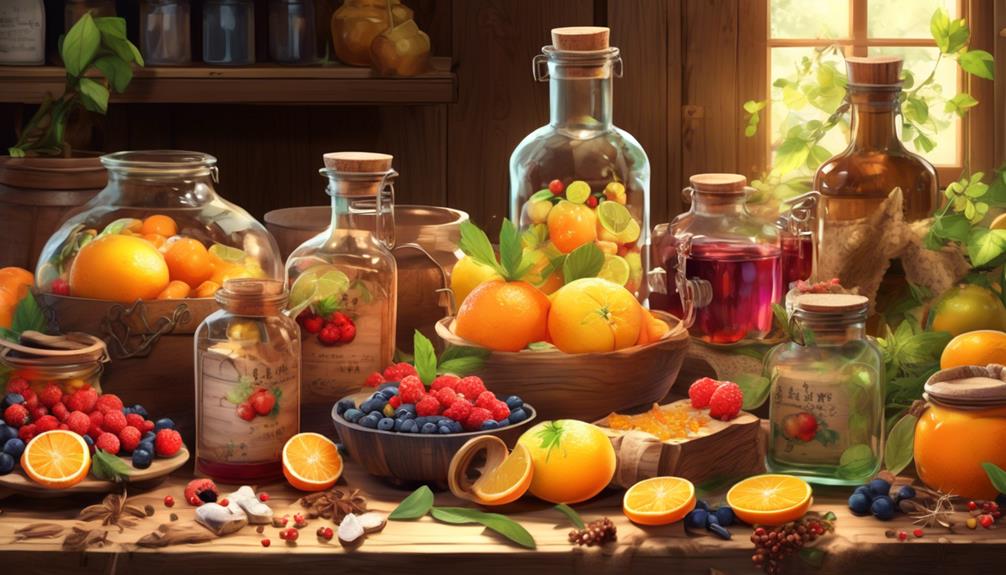
When selecting the right ingredients for making your own country wines, it’s important to consider the season and availability of fruits, vegetables, herbs, and flowers.
Country wines can be made from a wide variety of ingredients, allowing you to get creative and experiment with different flavors. While grape wines are popular, don’t be afraid to try non-grape wines using fruits like strawberries or vegetables like rhubarb.
To make wine at home, you’ll need high-quality ingredients.
The quality will directly impact the final product.
For non-grape wines, consider the sugar, yeast, and additional additives needed to achieve the desired flavor and fermentation process. Experiment with different sweeteners like honey, cane sugar, or brown sugar to find the perfect balance for your homemade wine.
Concentrated fruit juices can also be used to intensify the flavors.
Some recipes may require additional ingredients like tannin powder or acid powder to enhance the taste. Alternatively, you can use citric acid for a similar effect. Don’t forget to add yeast nutrient to ensure a healthy fermentation process.
Unique Wine Making Ingredient Ideas
Here’s a handy chart to give you some idea as to the various different types of fruits, vegetables, herbs, and flowers that can be used to make homemade county wine. You’ll see there are a lot of possibilities to create uniquely flavored wines and this is by no means an exhaustive list:
| Type | Description | Characteristics |
|---|---|---|
| Fruits | ||
| Apples | Sweet or tart, widely available | Can produce a variety of flavors and styles |
| Grapes | Commonly used for winemaking, various varieties available | Rich in natural sugars, can produce both red and white wine |
| Cherries | Sweet or sour, rich flavor | Can add a fruity and vibrant taste to the wine |
| Plums | Sweet or tart, juicy | Can produce a rich and aromatic wine |
| Peaches | Sweet, juicy, and fragrant | Adds a delicate and fruity flavor to the wine |
| Pears | Sweet or tart, crisp texture | Can produce a light and refreshing wine |
| Berries | Strawberries, raspberries, blackberries, blueberries, etc. | Add a sweet and tangy flavor to the wine |
| Vegetables | ||
| Tomatoes | Juicy and acidic, rich flavor | Can add depth and complexity to the wine |
| Pumpkins | Sweet and earthy taste | Can produce a unique and spiced wine |
| Squash | Nutty and sweet flavor | Adds a rich and smooth taste to the wine |
| Rhubarb | Tart and tangy, bright red stalks | Can produce a unique and tart wine |
| Herbs | ||
| Basil | Aromatic, sweet, and slightly peppery | Adds a subtle and herbal note to the wine |
| Rosemary | Woody and fragrant | Imparts a herbal and pine-like flavor to the wine |
| Lavender | Floral and slightly sweet | Can add a delicate and calming aroma to the wine |
| Mint | Refreshing and cooling | Adds a fresh and minty taste to the wine |
| Thyme | Earthy and slightly lemony | Imparts a subtle and savory note to the wine |
| Flowers | ||
| Elderflower | Fragrant and subtly sweet | Adds a delicate floral aroma and taste to the wine |
| Hibiscus | Vibrant and tart | Can produce a deep red wine with a tangy flavor |
| Chamomile | Mild and floral | Imparts a soothing and aromatic quality to the wine |
| Violet | Fragrant and slightly sweet | Adds a floral and perfumed note to the wine |
| Dandelion | Slightly bitter and earthy | Can produce a unique and herbal wine |
NOTE: Please note that the characteristics mentioned above are general and can vary depending on the specific variety and ripeness of the ingredient used.
With the right ingredients and a passion for winemaking, you can create your own country wines that rival those found in stores. So go ahead and give it a try, and soon you’ll be enjoying a glass of your very own strawberry wine or any other homemade creation.
Understanding Common Additives
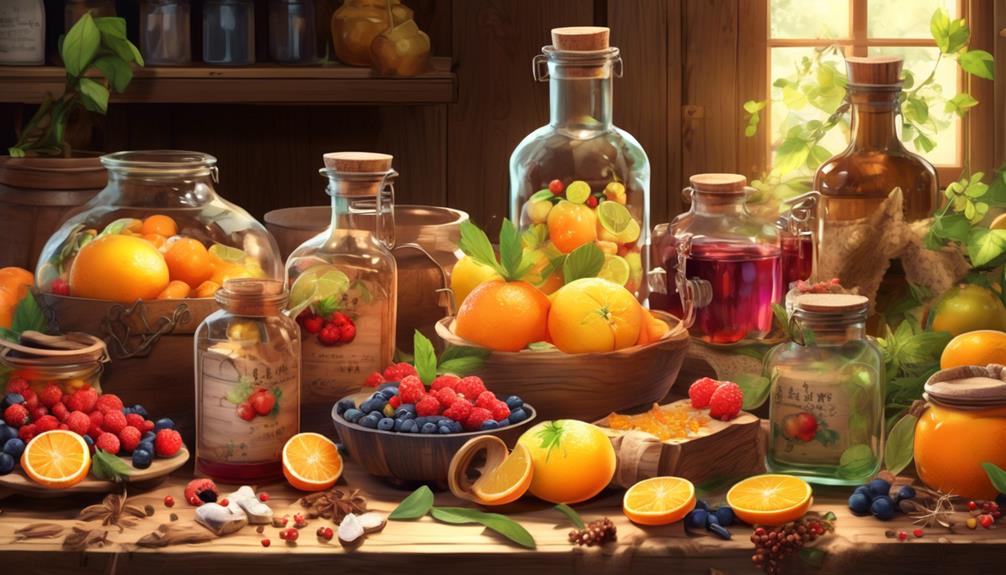
To fully master the art of making country wines, it’s essential to understand the role and significance of common additives in the winemaking process. These additives play a crucial role in ensuring the quality and stability of your homemade wine.
Here are three common additives that you should be familiar with:
- Campden tablets: These tablets are used to kill bacteria, stabilize the wine, and preserve its flavors. Before transferring your wine from one container to another or bottling it, adding Campden tablets will help prevent any unwanted microbial growth and ensure the longevity of your wine.
- Tannins: Tannins add complexity and structure to your wine. They can be derived from various sources such as black tea or lemon, or you can use specific tannin or citric acid additives. By adding tannins, you enhance the mouthfeel and flavor profile of your wine, creating a more enjoyable drinking experience.
- Potassium sorbate: This additive is commonly used to prevent yeast from fermenting any added sugars. When you want to sweeten your wine without the risk of refermentation, adding potassium sorbate is essential. It halts the yeast’s ability to produce carbon dioxide, ensuring that your wine remains sweet and stable.
Understanding these common additives will empower you to make a wine that isn’t only delicious but also long-lasting. By using Campden tablets, tannins, and potassium sorbate, you can create a wine that you can proudly share with friends and family.
‘Did You Know? The practice of adding tannins to wine dates back to ancient Rome. Romans used to boil wine skins in their wine to extract tannins, enhancing both the flavor and the longevity of their beverages. This early use of additives demonstrates how intrinsic they’re to the process of crafting quality wines.’
Choosing the Appropriate Yeast
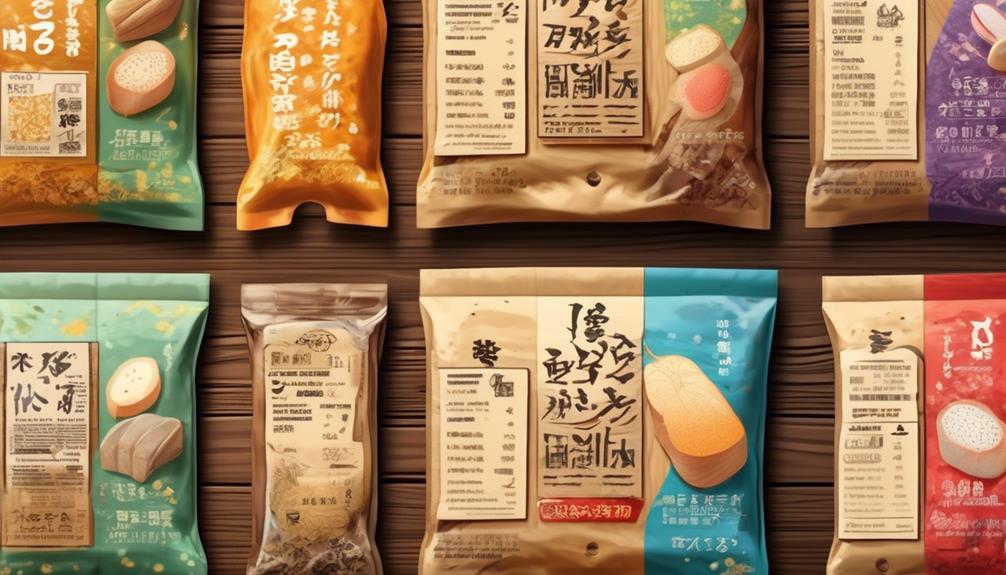
Once you have a thorough understanding of the common additives used in country winemaking, the next crucial step is choosing the appropriate yeast for your homemade wine.
The yeast you select will greatly influence the flavor, aroma, and overall character of your country wine. When making wine from non-grape fruits or vegetables, it’s important to consider the type of fruit or vegetable being used and match it with a suitable yeast strain. For example, if you’re making elderberry wine, you may want to use a yeast strain that enhances the natural berry flavors.
Additionally, consider the alcohol tolerance of the yeast to achieve the desired level of alcohol in your wine. If you prefer a sweet wine, choose a yeast strain that has a lower tolerance for alcohol, as this will result in a higher residual sugar content. On the other hand, if you want a dry wine, opt for a yeast strain with a higher alcohol tolerance.
It’s also important to determine if the yeast strain requires specific nutrients for optimal fermentation. Some yeast strains may need additional nutrients such as pectic enzyme to help break down the fruit or vegetable matter and facilitate the fermentation process.
Finally, research and understand the recommended fermentation temperature range for the yeast strain you choose. Each yeast strain has an optimal temperature range for fermentation, and maintaining the correct temperature will ensure that the yeast performs at its best, resulting in a high-quality country wine.
The Step-by-Step Process of Wine Making
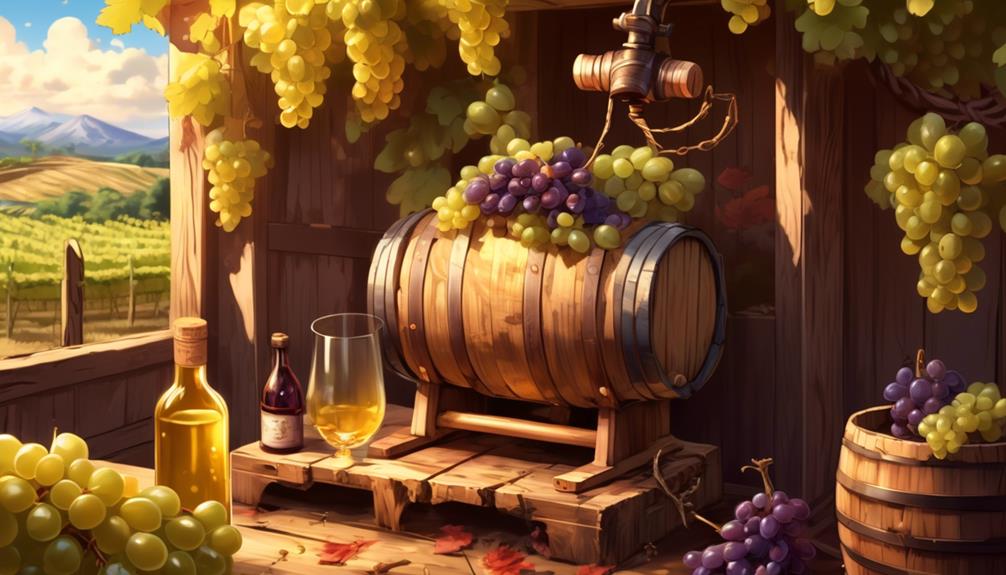
Here’s the step-by-step process of creating your very own country wine. Making homemade country wines is a fulfilling and rewarding experience that allows you to unleash your creativity and savor the flavors of nature. So, let’s get started!
- Gather your ingredients: Start by selecting your preferred fruits, vegetables, herbs, or flowers. The choice is yours, and it’s where the magic begins. Be sure to choose high-quality, ripe ingredients for the best results.
- Initiate the fermentation: Combine your chosen plant material with water and sugar or honey in a large bucket. Let the mixture cool down before adding the yeast. The yeast will consume the sugar and convert it into alcohol, giving your wine its characteristic flavor and aroma. Allow the mixture to ferment for the specified time, usually a few weeks.
- Strain and transfer: Once the fermentation is complete, strain the liquid from any pulp and transfer it into a glass carboy / demijohn using a large plastic tube. This step helps remove any sediment or impurities from the wine. Fit a rubber stopper and airlock to the carboy, allowing carbon dioxide to escape while keeping out air and bacteria.
- Monitor the process: Find a warm spot to store your carboy and keep an eye on the bubbles. The fermentation process will produce bubbles for about 4-6 weeks. Once the bubbles cease, it’s a sign that the wine has finished fermenting.
- Bottle and age: Carefully siphon the wine into bottles, cork them, and allow the wine to clear. This process may take a few months, but it’s worth the wait. Store the bottles on their sides in a wine rack to prevent the corks from drying out.
Congratulations! You’ve successfully made your first batch of homemade country wine. Cheers to the joy of winemaking and the sense of belonging that comes from being a part of this age-old tradition!
‘Did You Know? The art of winemaking, also known as viniculture, dates back to the Neolithic period around 7000 B.C., making it one of the oldest known forms of agriculture. The first wines were likely made from wild grapes and stored in animal skins or clay pots. It’s amazing to think that the process we use today has such ancient roots!’
Bottling and Storing Your Homemade Wine

When it comes to bottling and storing your homemade wine, proper techniques and attention to detail are essential for preserving the flavors and aromas you worked so hard to create.
After the fermentation process is complete, it’s time to transfer your wine into bottles. Before bottling, ensure that the bottles are clean and sterilized to prevent any unwanted bacteria from affecting the quality of your wine.
Use a siphon or a funnel with a filter to transfer the wine into the bottles, being careful not to disturb the sediment at the bottom. Leave about an inch of headspace in each bottle to allow for expansion during storage.
Once your wine is bottled, it’s crucial to store it in the right conditions.
Find a cool, dark place where the temperature remains constant, preferably between 55-65°F (12-18°C). Avoid storing your bottles of wine in direct sunlight, as this can degrade the flavors and colors. Wine is a delicate substance, and it’s highly susceptible to changes in temperature and light exposure.
If you plan to age your wine, make sure to lay the bottles on their sides to keep the corks moist and prevent them from drying out. This will help maintain a proper seal and prevent any oxidation.
Additionally, it’s important to keep track of the aging process and make notes on each bottle, such as the date it was bottled and any tasting observations. This will allow you to monitor the development and determine the optimal time to enjoy your homemade wine.
Well Done Winemaker…
In the world of winemaking, crafting your own country wine at home is a journey of creativity and exploration. With a range of ingredients and equipment at your disposal, you can uncover the artistry of turning fruits, vegetables, herbs, and flowers into delicious wines.
From the vibrant notes of rhubarb and blackcurrant to the delicate essence of rose petal and strawberry, each batch is a unique creation. So why not embark on this flavorful adventure and savor the satisfaction of enjoying your very own homemade wine? Cheers to the possibilities!
